Intel Teases Ice Lake-U Integrated Graphics Performance
by Ian Cutress on May 26, 2019 11:05 AM EST- Posted in
- GPUs
- Intel
- graphics
- Trade Shows
- Ice Lake
- 15W
- Sunny Cove
- Computex 2019
- Gen11

Another snippet of information from Intel today relates to the company’s future mobile platform CPU. We know it’s called Ice Lake-U, that it is built on Intel’s 10nm process, that it has Sunny Cove cores, and has beefy Gen11 integrated graphics. We’re still waiting on finer details about where it’s going to be headed, but today Intel is unloading some of its integrated graphics performance data for Ice Lake-U.
It should be noted that this data is performed by Intel, and we have had no ability to verify it in any way. Intel shared this information with a number of press in order to set a level of expectations. We’ve been told that this is Intel’s first 1 TeraFLOP graphics implementation, and it performs as such. The presentation was given by Ryan Shrout, ex owner and editor-in-chief of PC Perspective, and data was performed by his team inside Intel.
Ryan first showed us a direct comparison between the Gen9 graphics found in Intel’s latest and best Whiskey Lake platform at 15W up against a 15W Ice Lake-U product. The results make for pleasant reading. In the game demo scenes that Intel showed us, we saw upwards of a 40% gain in performance in average frame rates. Percentile numbers were not shown.
When comparing to an equivalent AMD product, Intel stated that it was almost impossible to find one of AMD’s latest 15W APUs actually running at 15W in a device – they stated that every device they could find was actually running one of AMD’s higher performance modes. To make the test fair, Intel pushed one of its Ice Lake-U processors to the equivalent of a 25W TDP and did a direct comparison. This is essentially AMD’s Vega 10 vs Intel’s Gen 11.
For all the games in Intel’s test methodology, they scored anywhere from a 6% loss to a 16% gain, with the average somewhere around a 4-5% gain. The goal here is to show that Intel can focus on graphics and gaming performance in ultra-light designs, with the aim to provide a smooth 1080p experience with popular eSports titles.
Update: As our readers were quick to pick up on from Intel's full press release, Intel is using faster LPDDR4X on their Ice Lake-U system. This is something that was not disclosed directly by Intel during their pre-Computex presentation.
| Intel Test Systems Spec Comparison | |||||
| Ice Lake-U | Core i7-8565U (WHL-U) |
Ryzen 7 3700U (Zen+) |
|||
| CPU Cores | 4 | 4 | 4 | ||
| GPU | Gen 11 (<=64 EUs?) |
UHD Graphics 620 (24 EUs) |
Vega 10 (10 CUs) |
||
| Memory | 8GB LPDDR4X-3733 |
16GB DDR4-2400 |
8GB DDR4-2400 |
||
| Storage | Intel SSD 760P 256GB |
Intel SSD 760P 512GB |
SK Hynix BC501 256GB |
||
For some background context, LPDDR4X support is new to Ice Lake-U, and long overdue from Intel as a consequence of Intel's 10nm & Cannon Lake woes. It offers significant density and even greater bandwidth improvements over LPDDR3. Most 7/8/9th Gen Core U systems implemented LPDDR3 for power reasons, and OEMs have been chomping at the bit for LPDDR4(X) so that they don't have to trade off between capacity and power consumption.
That Intel used LPDDR4X in Ice Lake-U versus DDR4 in the AMD system means that Intel had a significant memory bandwidth and latency advantage – around 56%, on paper at least. This sort of differential matters most in integrated graphics performance, suggesting that this is one angle that Intel will readily leverage when it comes to comparisons between the two products.
Moving on, the last set of data comes from Intel’s implementation of Variable Rate Shading (VRS), which was recently introduced in DirectX 12. VRS is a technique that allows the game developer to change the shading resolution of an area on the screen on the fly, allowing a developer to reduce the amount of pixel shading used in order to boost performance, and ideally doing this with little-to-no impact in image quality. It is a new supported feature on Gen11, but it does require the game to support the feature as well. The feature is game specific, and the settings are tuned by the game, not the driver or GPU.
Intel showed that in an ideal synthetic test, they scored a 40% uplift with VRS enabled, and in the synthetic test comparing VRS on and off, that extra performance put it above an equivalent AMD Ryzen system. AMD’s GPU does not support this feature at this time.
Intel is also keen to promote Ice Lake as an AI CPU, due to its AVX512 implementation, and any software than can take advantage of AI can be equipped with accelerated algorithms to speed it up.
We expect to hear more about Ice Lake this week at Computex, given Intel’s keynote on Tuesday, but we also expect to see some vendors showing off their Ice Lake-U designs.
| Want to keep up to date with all of our Computex 2019 Coverage? | ||||||
 Laptops |
 Hardware |
 Chips |
||||
| Follow AnandTech's breaking news here! | ||||||


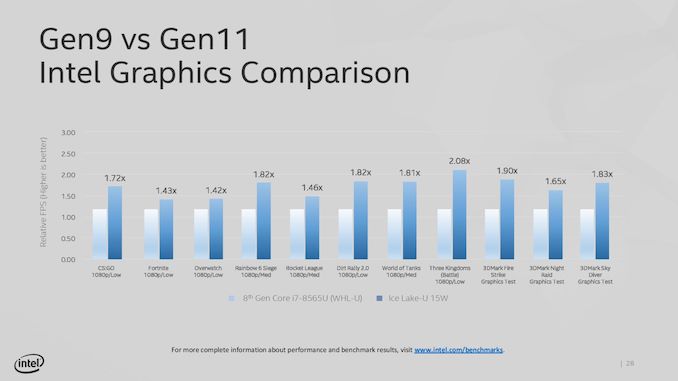
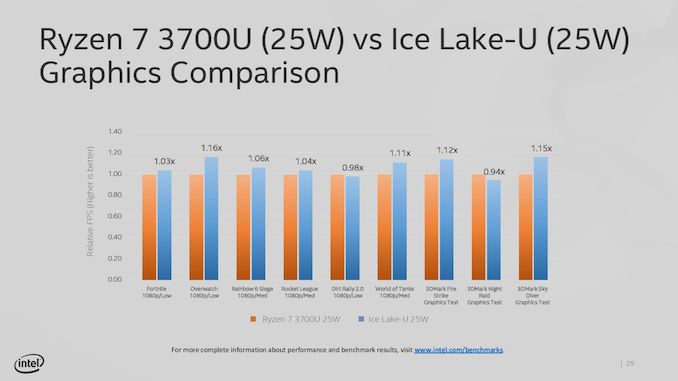
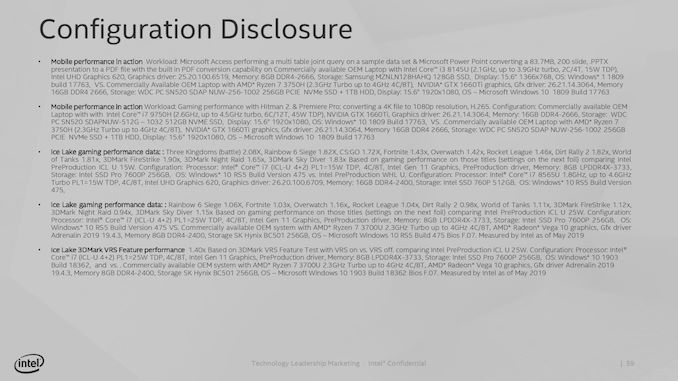
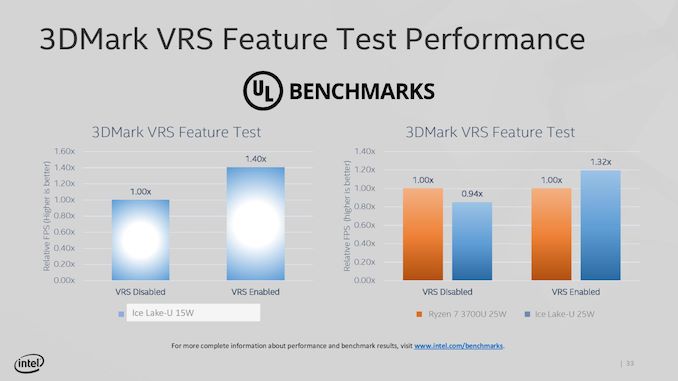
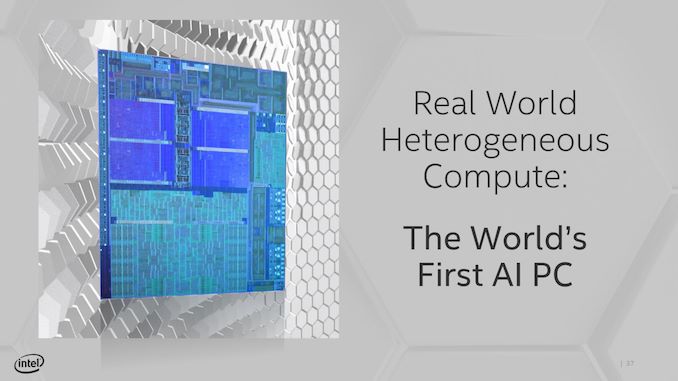








69 Comments
View All Comments
Billy Tallis - Sunday, May 26, 2019 - link
If these Ice Lake chips end up on the market paired with LPDDR4X, that RAM will be running at least this fast. This isn't an exotic speed for LPDDR4X, and the memory manufacturers have mostly moved on to even higher speeds (4266).ksec - Sunday, May 26, 2019 - link
May I ask Why AnandTech hasn't covered or mention, even in the news pipeline about Zombieload or MDS?Irish_adam - Sunday, May 26, 2019 - link
Might as well ask how much Intel paid them to put up an article and a pipeline story on a Sunday, I don't think I have ever seen anything published here on a Sunday. Not to mention the fact that there is no way Ian didnt notice the glaring problems with the benchmarks and so my guess is that this is paid for content by Intel the day before AMD has a reveal eventdarkswordsman17 - Sunday, May 26, 2019 - link
While I tend to give them plenty of leeway and have defended them some over some of this behavior (there's certainly some very petulant commenters on some articles), their silence on this is starting to be a problem for anyone that wants to give Anandtech credibility. Since they allegedly were waiting for official comment from Intel before discussing it, they should be telling Intel that until they address this major security issue (that is far bigger than stuff like this article is about or the 9900KS), that they won't publish any Intel stories. Its obvious Intel wants to stonewall things and ignore glaring screwups, but that only works if the media helps them. At some point they need to stop waiting for Intel (who is just going to blow smoke up their backsides anyway as we've seen with the Spectre/Meltdown situations) and actually do their own study into this or else they're just going to look like they're being paid off by Intel to coverup what is absolutely an outright fiasco.This coupled with their atrocious coverage of that ridiculous "security research" team trying to trash AMD makes Anandtech look really bad. Considering how they try to appear that they're so concerned about benchmark cheating (on Android at least...) and other security situations, them letting Intel slide on an issue that is both enabling them to cheat on benchmarks as well as creates a huge security problem on top of it, well its becoming absurd.
I'm starting to wonder if the recent hires of other tech media person by Intel isn't playing a role as well.
Ryan Smith - Sunday, May 26, 2019 - link
"This coupled with their atrocious coverage of that ridiculous "security research" team trying to trash AMD makes Anandtech look really bad."Do you mean CTS-Labs? Where Ian basically poked several large holes in their story when he interviewed them?
https://www.anandtech.com/show/12536/our-interesti...
HStewart - Sunday, May 26, 2019 - link
Because it not real news - who cares about this bs. Show me a real example of it.HStewart - Sunday, May 26, 2019 - link
Keep in mind this is IceLake - it has most of if not all migrations in hardware. End of story.Korguz - Sunday, May 26, 2019 - link
HStewart,keep in mind.. this is intel published benchmarks, and as such.. should be taken as cherry picked and taken with loads of salt, and considered as false and just a PR move by intel
Phynaz - Sunday, May 26, 2019 - link
And another one, priceless.Ryan Smith - Sunday, May 26, 2019 - link
"Might as well ask how much Intel paid them to put up an article and a pipeline story on a Sunday"This is part of our regular Computex coverage. Taiwan is 12 hours ahead of the US east coast, and vendors are already rolling out announcements on Sunday because there's so much going on the rest of the week.
"so my guess is that this is paid for content by Intel the day before AMD has a reveal event"
If it were paid content (and I wouldn't approve of something like this), then it would be made very clear in the article that it was a sponsored news post.